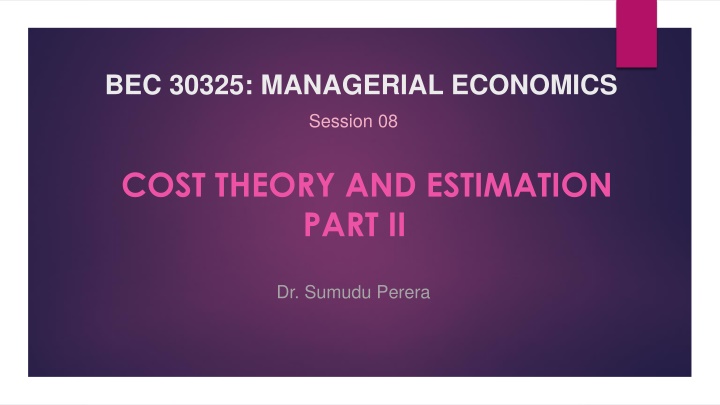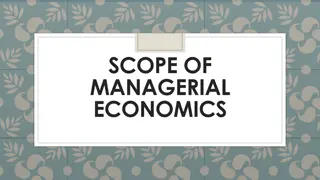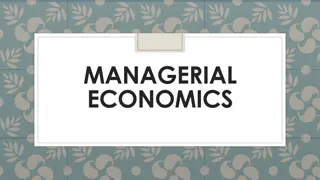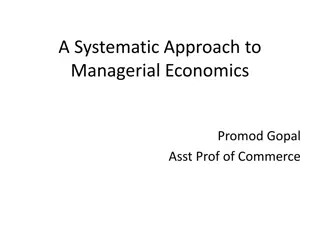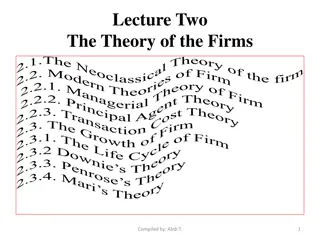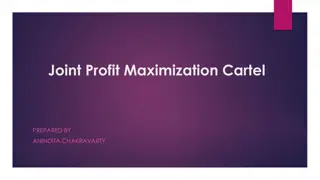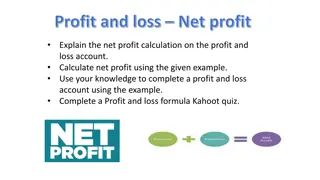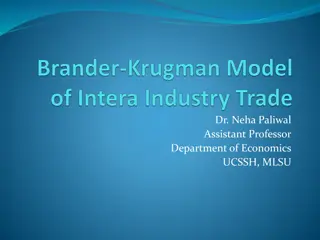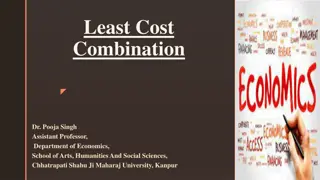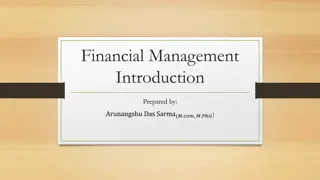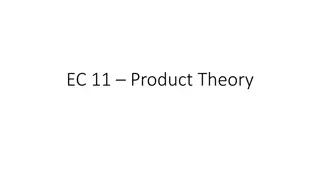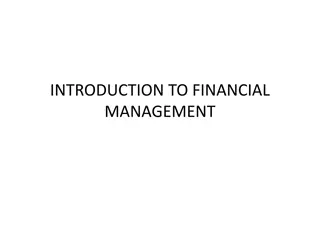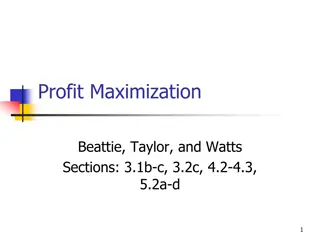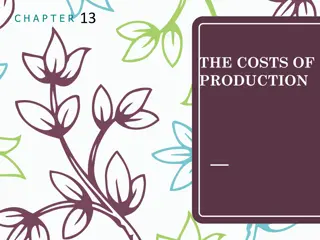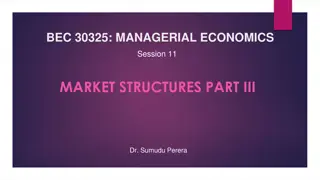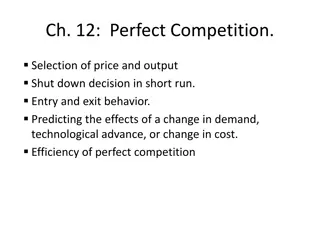Managerial Economics: Cost Theory and Profit Maximization
In this session, delve into the realms of cost theory and profit maximization in managerial economics. Explore topics such as profit maximization, economies of scale, cost-volume-profit analysis, break-even analysis, and more. Understand the strategies to optimize profits and the significance of internal economies of scale.
Download Presentation

Please find below an Image/Link to download the presentation.
The content on the website is provided AS IS for your information and personal use only. It may not be sold, licensed, or shared on other websites without obtaining consent from the author.If you encounter any issues during the download, it is possible that the publisher has removed the file from their server.
You are allowed to download the files provided on this website for personal or commercial use, subject to the condition that they are used lawfully. All files are the property of their respective owners.
The content on the website is provided AS IS for your information and personal use only. It may not be sold, licensed, or shared on other websites without obtaining consent from the author.
E N D
Presentation Transcript
BEC 30325: MANAGERIAL ECONOMICS Session 08 COST THEORY AND ESTIMATION PART II Dr. Sumudu Perera
2 Session Outline Profit Maximization Economies of Scale Diseconomies of Scale Economies of scope Learning Curves Cost-Volume-Profit Analysis Break-even Analysis Operating Leverage Dr.Sumudu Perera 21/03/2025
3 Profit Maximization Total Approach To maximize profit firm should; -Produce quantity of output where vertical distance between TR and TC curves is greatest and -TR curve should lie above TC curve Dr.Sumudu Perera 21/03/2025
4 Profit Maximization To maximize profits the firm should produce the level of output closest to point where MC = MR Level of output at which the MC and MR curves intersect Important exception to this rule Sometimes MC and MR curves cross at two different points In this case, profit-maximizing output level is the one at which MC curve crosses MR curve from below Dr.Sumudu Perera 21/03/2025
5 Marginal approach Dollars 600 MC 500 400 300 200 100 0 Output 7 1 2 3 4 5 6 8 100 profit rises profit falls 200 MR
Economies of Scale The advantages of large scale production that result in lower unit (average) costs (cost per unit) AC = TC / Q Economies of scale spreads total costs over a greater range of output The optimum output occurs at the Minimum Efficient Scale (MES)
Economies of Scale Unit Cost Scale A 82p Scale B 54p LRAC MES Output
Internal Economies of Scale Internal advantages that arise as a result of the growth of the firm Technical Commercial Financial Managerial Risk Bearing
Internal Economies of Scale continued Technical Specialisation large organisations can employ specialised labour Indivisibility of plant machines can t be broken down to do smaller jobs! Principle of multiples firms using more than one machine of different capacities - more efficient Increased dimensions bigger containers can reduce average cost
Internal Economies of Scale continued Commercial Large firms can negotiate favourable prices as a result of buying in bulk Large firms may have advantages in keeping prices higher because of their market power
Economies of scope If the cost of producing two products jointly is less than the cost of producing those two products separately then there are economies of scope between the two products. Cost(Q1, Q2) < Cost(Q1) + Cost(Q2)
Internal Economies of Scale continued Financial Large firms are able to negotiate cheaper finance deals Large firms are able to be more flexible about finance share options, rights issues, etc. Large firms are able to utilise skills of merchant banks to arrange finance
Internal Economies of Scale continued Managerial Use of specialists accountants, marketing, lawyers, production, human resources, etc. Risk Bearing Diversification Markets across regions/countries Product ranges R&D
External Economies of Scale External economies of scale the advantages firms can gain as a result of the growth of the industry normally associated with a particular area Supply of skilled labour Reputation Local knowledge and skills Infrastructure Training facilities
Diseconomies of Scale The disadvantages of large scale production that can lead to increasing average costs Problems of management Maintaining effective communication Co-ordinating activities often across the globe! De-motivation and alienation of staff Divorce of ownership and control
Learning Curves The learning curve shows the decline in the average input cost of production with rising cumulative total outputs over time. The learning curve also shows that the average cost is about $ 250 for producing the 100th unit at point F etc.. 16
Learning Curves Average Cost of Unit Q = C = aQb Estimation Form: log C = log a + b Log Q The Learning curve can be express algebraically as follows: (C is cost of the Qth unit of output) ln C = ln a + b ln Q Linearized version, can be easily estimated and interpreted. ln C = 3 0.3 ln Q If Q increases by 1%, then unit (average) costs decrease by 0.3%. Useful to make predictions for the future: how much does the average cost for the 100th unit as well as 200th: lnC =3 0.3ln100 = 2.4 = => C = antilog of (2.4) =$251.19 lnC =3 0.3ln200 =2.31= =>C = antilog of (2.31) =$204.03 17
Cost-Volume-Profit Analysis Cost-volume-profit or breakeven analysisexamines the relationship among the TR, TC, and total profits of the firm at various levels of ooutput. This technique is often used by business executives to determine the sales volume required for the firm to break even and the total profits and losses at other sales levels. The analysis uses a cost-volume-profit chart in which the TR and TC curves are represented by straight lines and the break-even o/p (QB) is determined at their intersection. 18
Cost-Volume-Profit Analysis The slope of the total revenue TR curve refers to the product price of $10 per unit. The vertical intercept of the total cost of (TC) curve refers TFC of $200, and the slope of the TC curve to the AVC of $5. The break-even with TR=TC $400 at the output (Q) of $40 units per time period at the point B. 19
Cost-Volume-Profit Analysis Total Revenue = TR = (P)(Q) Total Revenue = TR = (P)(Q) Total Cost = TC = TFC + (AVC)(Q) Total Cost = TC = TFC + (AVC)(Q) Breakeven Volume TR = TC (P)(Q) = TFC + (AVC)(Q) QBE = TFC/(P - AVC) 20
Break-even o/p QBE = TFC/(P - AVC) P = 40 TFC = 200 AVC = 5 QBE = 40 21
Operating Leverage and the other concepts Operating leverage: The ratio of the firm s total fixed costs to its total variable costs. Contribution margin per unit: The excess of the selling price of the product over the average variable costs of the firm (i.e. P-AVC) that can be applied to cover the fixed costs of the firm and to provide profits. Degree of operating leverage (DOL): The percentage change in the firm s profits divided by the percentage change in output or sales; the sales elasticity of profits. 22
Operating Leverage Operating Leverage = TFC/TVC Degree of Operating Leverage = DOL % % ( ) Q P AVC = = DOL ( ) Q Q P AVC TFC 23
Operating Leverage The intersection of TR and TC defines the break even quantity of QB=40. With TC , the break even quantity increases QB =45. TC has a higher DOL than TC and therefore a higher QBE to 24
